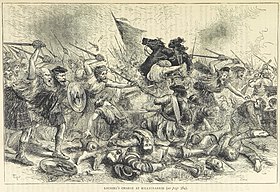Our website is made possible by displaying online advertisements to our visitors.
Please consider supporting us by disabling your ad blocker.
Battle of Killiecrankie
| Battle of Killiecrankie | |||||||
|---|---|---|---|---|---|---|---|
| Part of the Jacobite Risings | |||||||
 Lochiel's charge at Killycrankie by James Grant | |||||||
| |||||||
| Belligerents | |||||||
|
|
| ||||||
| Commanders and leaders | |||||||
|
Hugh Mackay Barthold Balfour † |
Viscount Dundee † Ewen Cameron Alexander Cannon Alexander Fraser † | ||||||
| Strength | |||||||
| 3,600 – 5,100 men | 2,440 – 3,000 men [1] | ||||||
| Casualties and losses | |||||||
| 1,700 – 2,000 killed, wounded and missing | 700 killed and wounded | ||||||
| Designated | 21 March 2011 | ||||||
| Reference no. | BTL12 | ||||||
The Battle of Killiecrankie,[a] also known as the Battle of Rinrory, took place on 27 July 1689 during the 1689 Scottish Jacobite rising. An outnumbered Jacobite force under Sir Ewen Cameron of Lochiel and John Graham, Viscount Dundee, defeated a government army commanded by General Hugh Mackay.
James VII went into exile in December 1688 after being deposed by the Glorious Revolution in Scotland. In March 1689, he began the Williamite War in Ireland, with a simultaneous revolt led by Dundee, previously military commander in Scotland.
Hampered by lack of men and resources, Dundee gambled on a decisive battle which he hoped would attract wider support. Although Killiecrankie was an unexpected and stunning victory, his army suffered heavy casualties and he was killed in the final minutes. It did little to change the overall strategic position, and the Jacobites were unable to take advantage of their success.
- ^ The Inventory of Historic Battlefields – Battle of Killiecrankie (PDF). Edinburgh: Historic Scotland. 2011. Retrieved 19 January 2020.
Cite error: There are <ref group=lower-alpha> tags or {{efn}} templates on this page, but the references will not show without a {{reflist|group=lower-alpha}} template or {{notelist}} template (see the help page).
Previous Page Next Page


